Muscat, Oman March 22
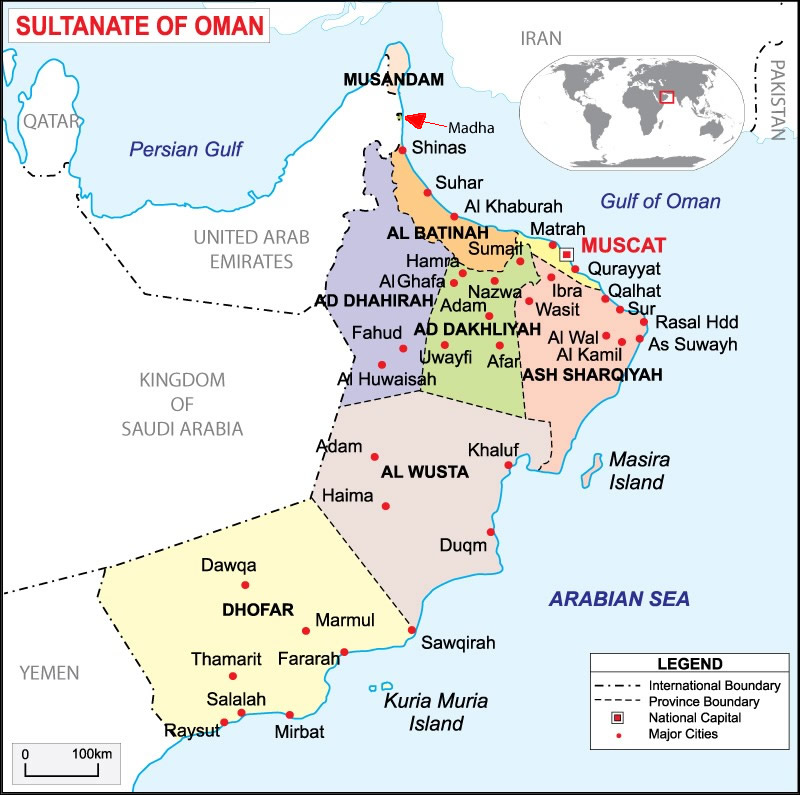
The map is From Wikipedia Oman.
Note the non-contiguous parts of Oman. One at the tip of that peninsula and another small part between most of Oman and the tip. To drive from Muscat to Musandam one has to go through border formalities to leave Oman and enter the Arab Emirates, leave it and enter the next part of Oman called Madha, leave and reenter the Arab Emirates, and finally cross the border with Musanda. When the borders were set up Musabdan and Madha, wanted to be part of Oman instead of the United Arab Emirates.
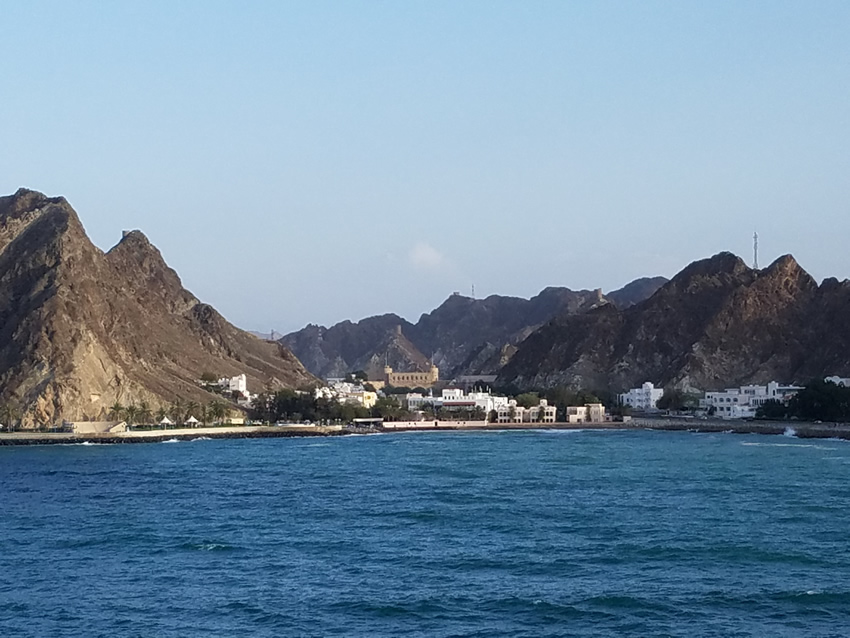
Above is one of the first scenes we saw entering Muscat.
The Sultanate of Oman, the official name of Oman. A year ago I could never have found it on a map of countries on which countires were not labeled. “It’s just a country in that messy part of the world, the Middle East, right?” Partly true, but today it is more like an oasis. A great relief from the noisy, crowded Mumbai. Highways, absolutely clean (one can be fined for having a dirty car), no horns blaring, no motorcycles, and minimal traffic with plenty of road to handle what there is. There are few stop lights, but mostly there are roundabouts, some with statutes, and others with landscaping, but none that are bare. It is a rich Sultan who has spared little oil money to make this part of the country pleasant and peaceful. I can’t speak of the rest of the country.

Above is one of the many roundabouts, they all different, some are flowers, many with "statues such as above."
It is an absolute monarchy, with most government positions filled by family members. The Sultan appoints and removes journalists. There are censorship and torture for those who present a threat to the current government. That’s the negative.
The current Sultan, Sultan Qaboos bin Said (Qaboos is pronounced caboose…) removed his father from power in a 1970 bloodless coup, sent him to Paris in exile, and proceeded to modernize the country. Under his father the country was mired in feudalism and isolationism. Education for women, and the right to drive, as well as work outside the home were a few of the reforms. Highways and other infrastructure were built as well as schools. He also beautified the country, at least around Muscat.
The Sultan, who rumor has it is gay, is 75 and no one dares to guess what will happened when he dies. There is no gossip or news of the royal family. Although the role of Islam is very evident here; not upsetting the Imans too much was probably politically a smart move on his part. The Shah may have made that mistake in Iran. Culture does not change easily and Islam has power. Women who live there are expected to wear black tents and scarfs. Whether to wear the mask or not depends on the husband, except in one province in which it is mandatory, which I think is Dhofar but am not certain. Men must wear white dishdashis with a hat called the kummah. The dress codes applies only to the Omanis, however we were requested to respect their customs, that is women cover their shoulders and legs to the ankles. There were a few ugly Americans who flaunted this, but most of us were respectful. It is their country and we were guests.
The imans howl five times a day to call the faithful to prayer, but although all are Muslims, there is no requirement to actually pray. This branch of Islam prohibits the head from touching the ground, so one does not see the forehead protrusions one sees in Cairo.
The buildings in Muscat are white, or light beige and nestled on the shore between the sea and hills – I really can’t call those things mountains, although they would present a challenge to climb. To give you an idea of how dry the country is, the headline in the local paper read “Clouds May Bring Rain.” The dryness is visible in the bare rocks. Oman has started desalinization for water.
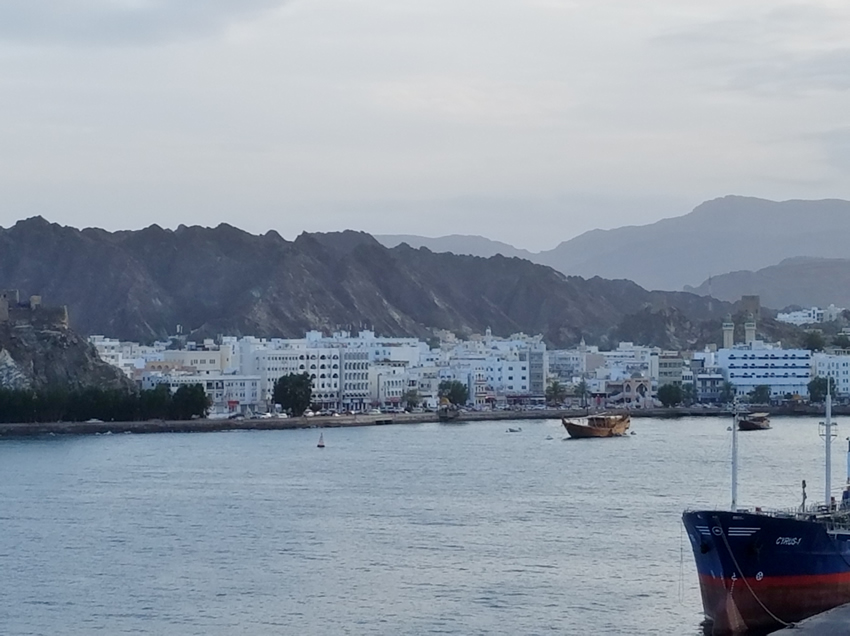
It is forbidden for the Omanis to work on construction sites. For that they have Indians and Pakistanis. Given that Oman was once the headquarters of the slave trade, something that fell apart in 1834 when Britain outlawed slavery, and my knowledge of Kuwait in which non-Kuwaitis have minimal rights, I am betting that conditions and salaries for these immigrants are not the greatest.
The Portuguese found this spot in 1507, took it from the then Sultan, and were tossed out by the Omanis in 1660. The lure for Muscat was the protection offered by the surrounding “mountains,” called Al Hajar. After getting rid of the Portuguese, the Omani Sultanate became a powerful empire, vying with both Portugal and Britain for control of the Straits of Hormuz and eastern Africa as far south as Zanzibar. When Oman's power declined in the 20th century it became influenced by Great Britain, but the British never colonized Oman.

That object on the hill is a model of a franckinsense burner. I know, it looks like it came from outer space. It overlooks the harbor. Some of these :mountains" have what look like caves in them.
Inspired by the Arab Spring uprisings taking place throughout the region, protests also occurred in Oman during the early months of 2011. Although they did not call for the ousting of the regime, demonstrators demanded political reforms, improved living conditions, and the creation of more jobs. They were dispersed by riot police in February 2011 and Sultan Qaboos reacted by promising jobs and benefits. In October 2011, elections were held to the Consultative Assembly (note the word consultative), for which Sultan Qaboos promised greater powers. The following year, the government began a crackdown on Internet criticism. In September 2012, trials began of 'activists' accused of posting "abusive and provocative" criticism of the government online. Six were given jail terms of 12–18 months and fines of around $2,500 each. (Quoted word for word from Wikipedia’s Oman – except that sentence about consultative.)
Which is all the history I will relate, although Oman's history can be traced to the Achaemenid Empire at its greatest territorial extent, under the rule of Darius the Great (522 BC to 486 BC).The oldest known human settlement in Oman dates back as many as 8,000 years to the Late Stone Age. They were in the past and recent past noted for Maritime accomplishments.
Although oil is the principal export and comes from wells beyond the Al Hajar mountains, there are no pipelines, and absent British colonialism no railroads, but many oil tankers on the road. Knowing that its oil will not last forever, Oman is trying to diversify to tourism, fish, dates, and wheat. Plus, it is the primary source of frankincense and myrrh – both evident in the Souk (market) in Muscat. The land in the south beyond the mountains, is good agricultural land. However, towards Saudi Arabia, much of the country is desert which explains why it was 1990 before these borders were drawn, no one really cared.
We were part of the tourism expansion, which dries up in summer when the temperature reaches to the 100s. During the day that we spent in Muscat, a Carnival Liner came in and blessed the Souk and other areas with its passengers who, just like us, spent money. Because we docked 12 hours ahead of schedule, we were able to take a shuttle bus from the ship to the Souk (market) that evening before the Carnival liner passengers. Muscat, and all of Oman are so clean! (This branch of Islam has a fetish with cleanileness – a good trait).
An area that makes about a 1/3 circle around the harbor and has shops at one end, and nice views of the harbor at the other is referred to as the Corniche. This is where the Souk is. The shops on Corniche main road were all about 6 or 7 big steps above the sidewak. The floor in some of the shops was as interesting as the merchandise. Some were of marble or hard tile, and had decorations in the floor. The main offerings, all made in India, were souvenirs of small items such as camels, incense burners, Aladdin’s lamp, and other assorted junk. There is an alley that goes off the main area where there are more shops.
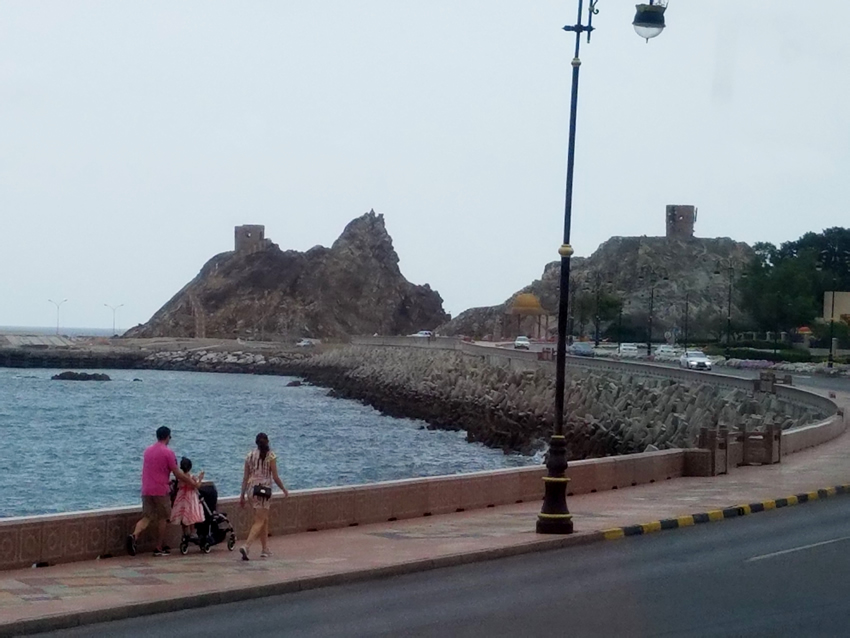
Above is the non-commerical part of the Corniche. Note the forts in the background. They blend into the surroundings and were built by the Portuguese.
In one of the few stores that also sold dishdashis (man’s clothes) a friend wanted to buy one with the intention of wearing it herself. When she held it up to see if it would fit, the man grabbed it back and said that it was only for men. She should have told him that it was for her boyfriend… The shops also had many beautiful scarves, pashminas, cotton tops with embroidery, and beautiful dresses that I would wear once on the ship and never again so I did not buy. Again, all made in India. The Corniche also had the Islamic bank of Muscat, but I have no idea how they get around the Islamic creed of no usury. But this is their own brand of Islam.

A view as we entered the Grand Mosque. Note the ground (How can one call this ground? It is more like a floor, all marble.) There is a machine like a hockey zamboni that regularly cleans here and other ground areas.
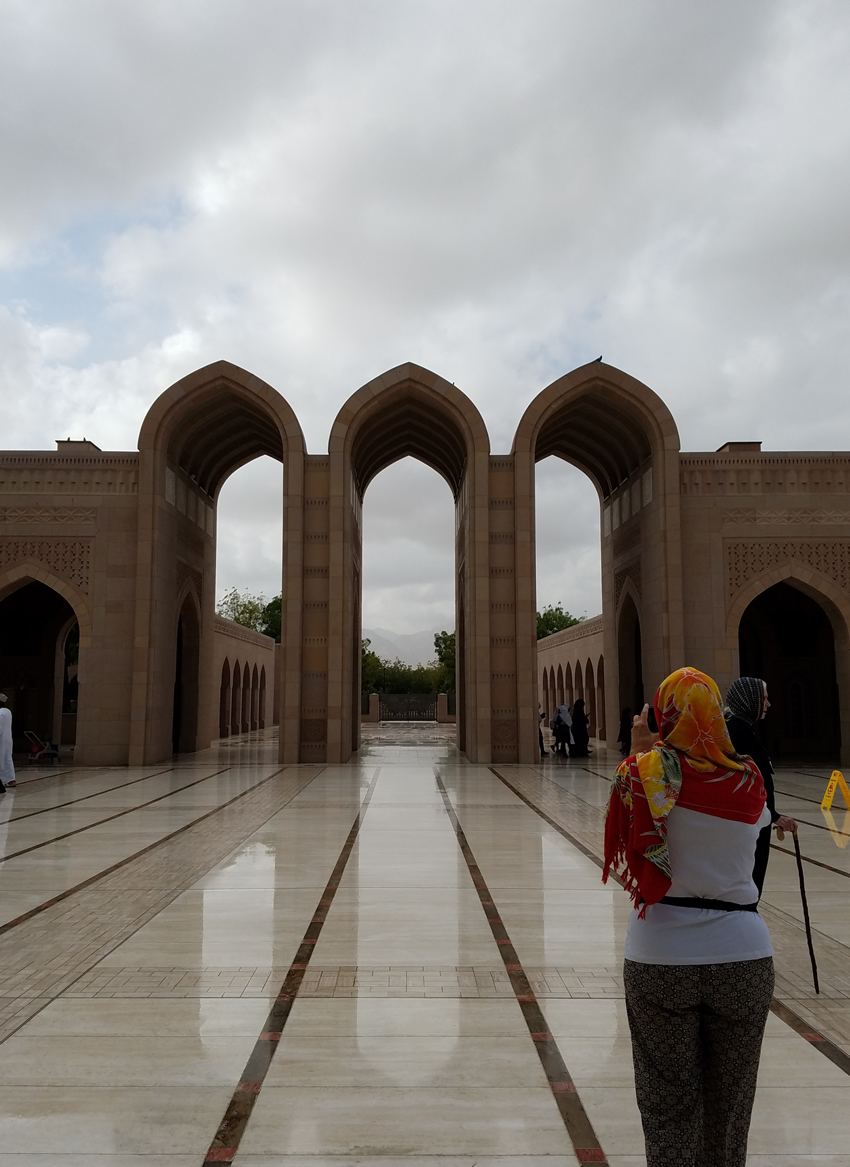
Settings inside the mosque Sultan Qaboos Grand Mosque of Oman, but on the extensive grounds.
The inside deigns were impeccable, from ceiling, chandeliers, walls, to the supporting poles that had decorations on the bottom. I could envision tourists in about one or two thousand years looking at its ruins with a guide droning on about it’s beautiful past, which the then tourists will never be able to visualize.
It has the world’s largest one piece handmade carpet (Persian) in the world. The picture below hardly does justice.
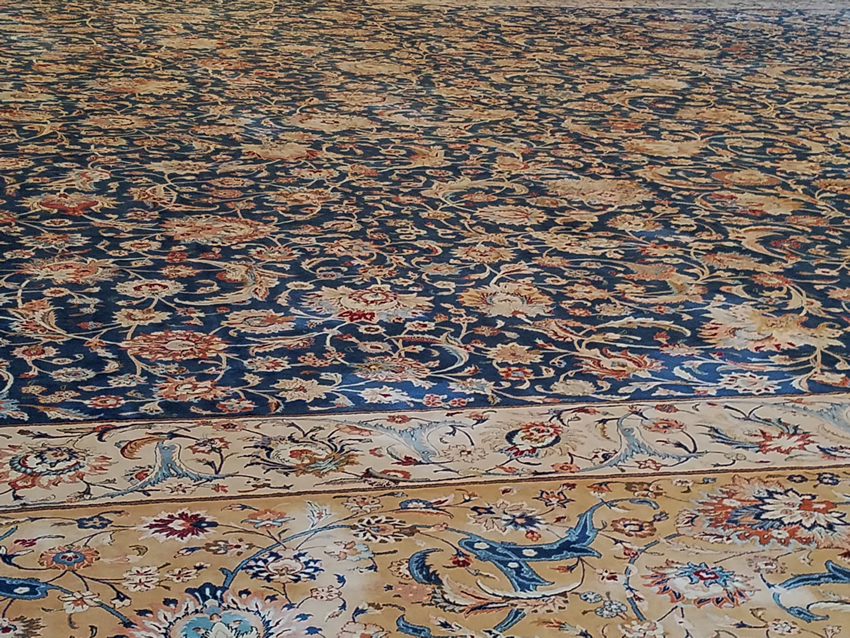
Infidels are permitted inside, if they remove their shoes and are suitably clothed. This means long pants for both men and women, long sleeves and complete hair covering for women. They did not have gowns for those not attired correctly, but by now we knew what to do.
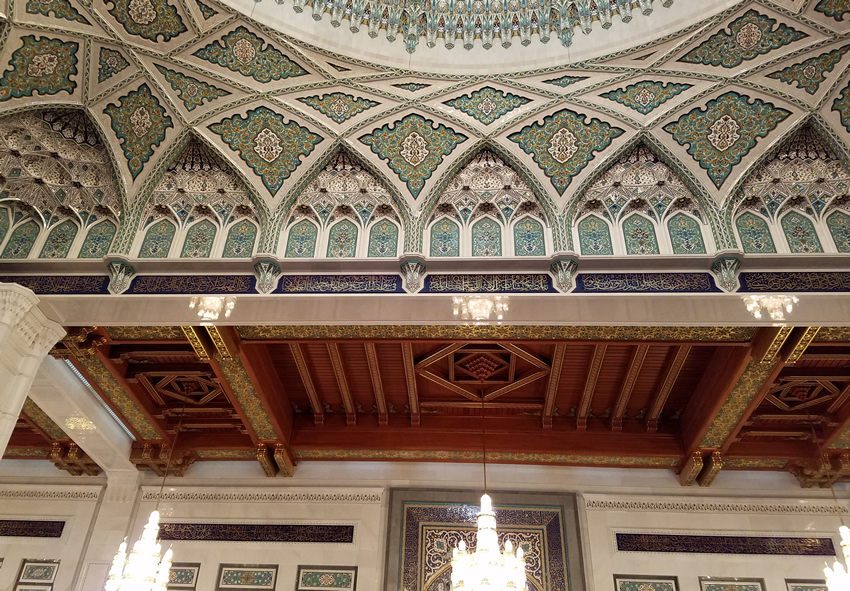
Above you see the ceiling in its wood designs and part of the arch. I can't capture this place in pictures, the colors are really more brilliant.
From that exquisite experience, we went to view the outside of the Sultan’s Al Alam Palace (BTW Both of these were built in THIS century). The only people permitted inside are the Sultan, his ministers etc., and invited guests. He does not live there, but there is a guest house next to the Palace where distinguished visitors can stay. We could only take pictures of the outside. Palace below.
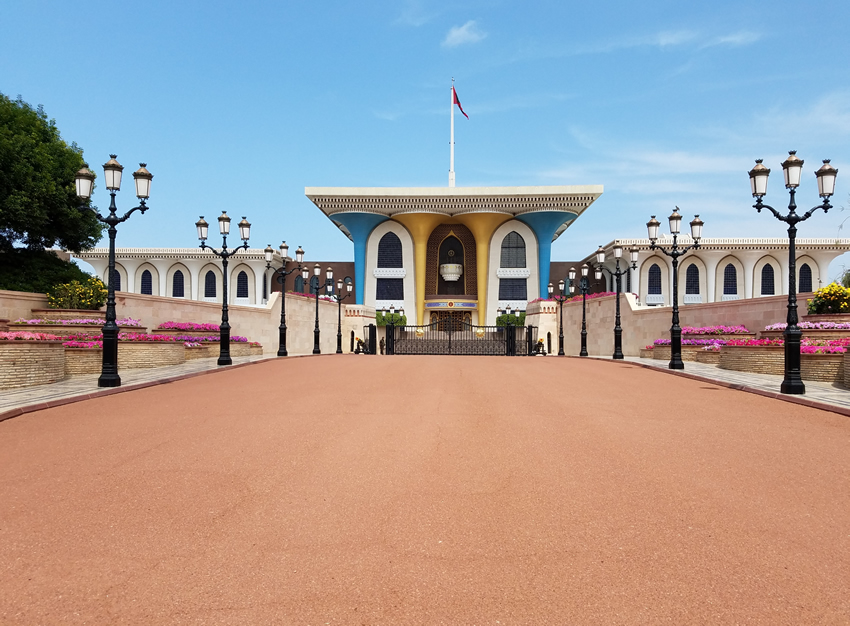
A bit about this Sultan. He has given a lot of his money, or should I say Omanis money from their oil to the country and as Middle Eastern potentates go, he is good. However, he spends a lot of time in Geneva, has 7 palaces and 2 ships. I can’t call either of them a yacht, they are too big. If you can distinguish in this picture the two you can see what I mean. When we first docked I thought that the big one was another cruise ship, but the Captain set us straight. I tried to outline the bow of the larger one in red.
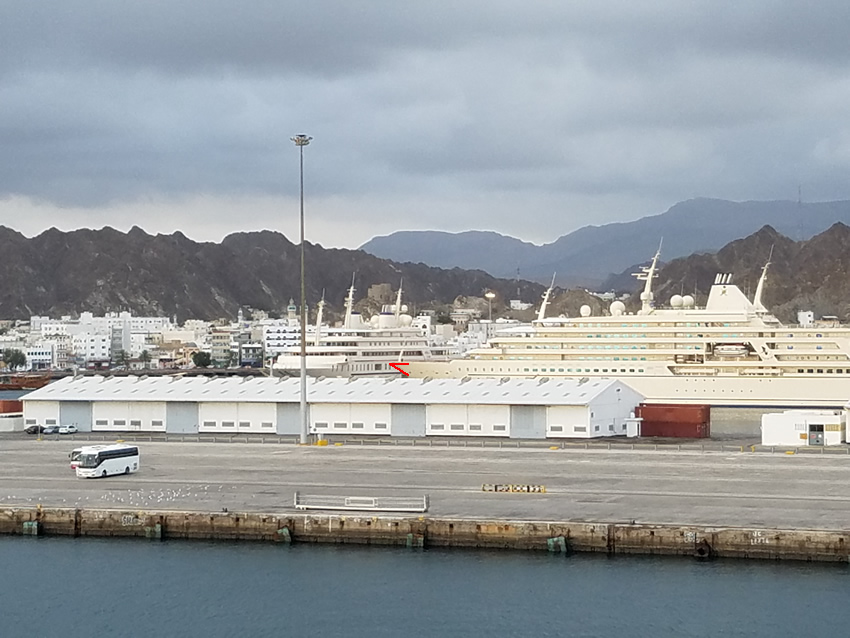
It is always imperative to visit a museum and the first one we visited is another of the Sultan’s creations. It's name is officially the Bait Al Zubar Museum. Photos were prohibited inside. The one floor contents included gorgeous dresses that reminded me of the Arabian Nights, and some of the famous curved daggars known as Khanjars. The daggar is in the shape of an L with the blade being the end of the L. It is a requirement that this be worn in its sheath (at least I hope that it is sheathed, we were never told.) in the belt at weddings, and formal occasions. The Sultan must always wear one. There were also mockups of typical rooms in an Omani house. Outside were models of painted onyxes, which are found in one of the provinces. They are a favorite animal.
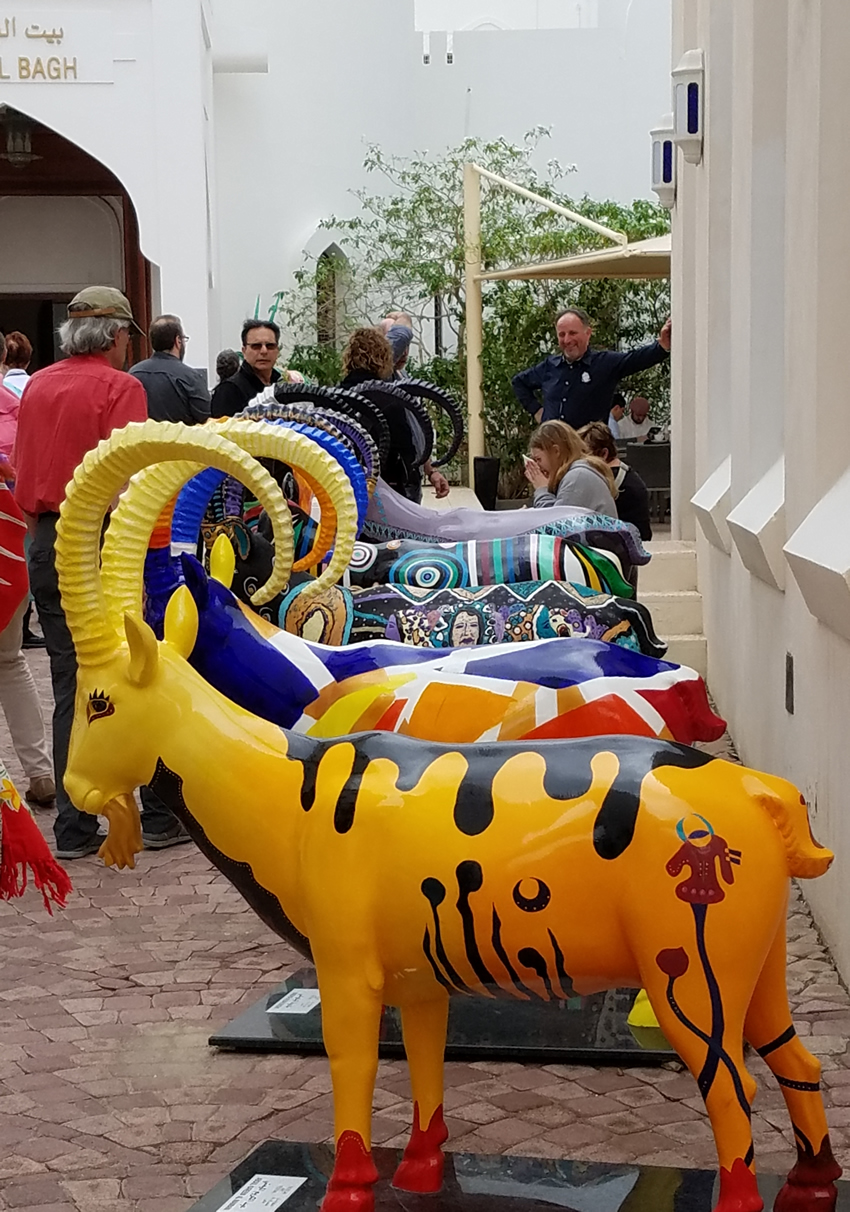
Lunch! At the entrance, there was frankincense burning, then we followed the guide through paths, beautifully landscaped, passing outside tables, and other paths to finally enter the place where a buffet awaited us. (I got lost going back to the entrance to the “happy room” and coming back!) We were greeted with a typical welcoming drink that is minty, has lemon and I don’t know what else, but is very refreshing (I’ve used the word delicious too many times, but it was.) Lunch was, yes, delicious. I could get addicted to Middle Eastern food, spiced just right, emphasis on vegetables and chicken. One of my regrets is that I cannot capture the various fragrances that we have experienced, especially in the foods. Below is a picture of part of the path to the food.
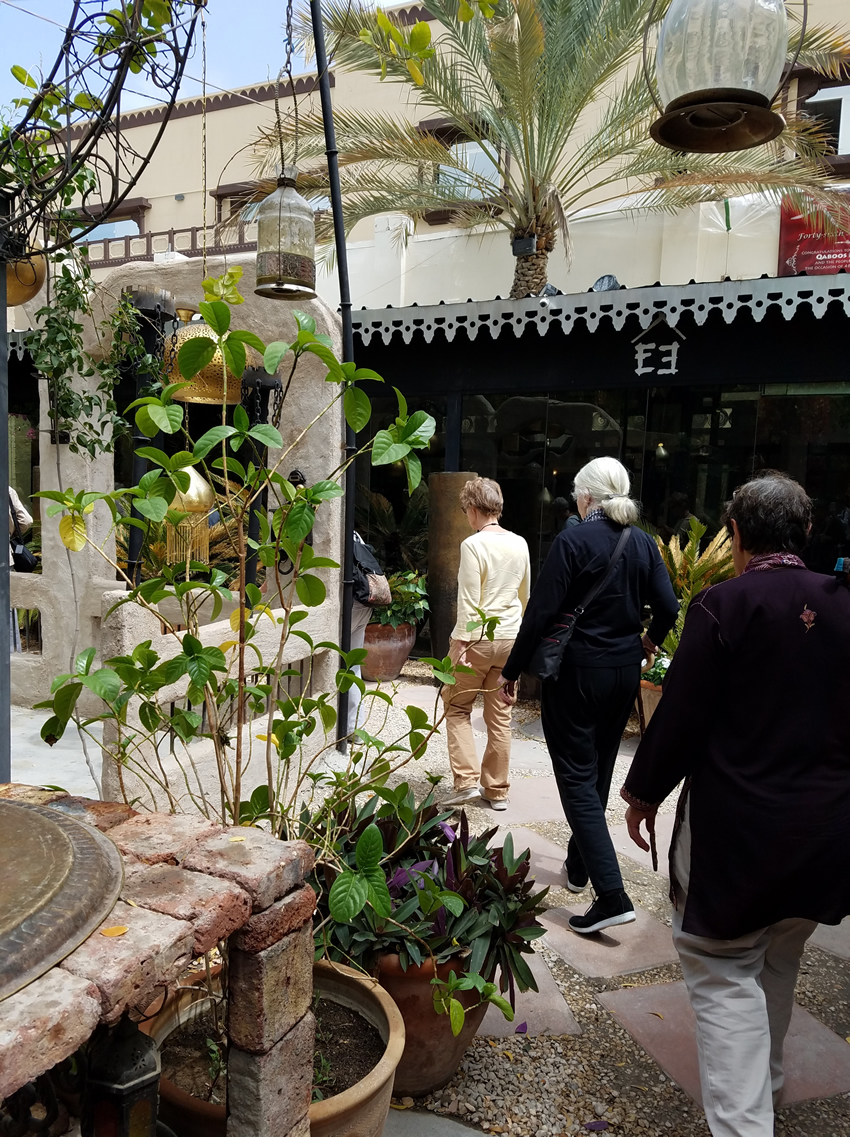
Lunch once again a memory we proceeded to another museum, the Bait Adam Museum which has very little in the way of exhibits, but was owned by a man who wanted to tell us about Oman. He told us that the first Arab Ship arrived in New York in 1840 and was an Omani ship. Because the country keeps a low profile it was not generally known that the conference which ended Desert Storm was agreed to in Muscat, although officially signed in Geneva. Also, the three hikers who strayed over the border with Iran and were arrested were ransomed by the Sultan who flew them to their waiting parents in Muscat and from there back to the U.S.
At this museum we also had a “cooking lesson” on how to make three Middle Eastern foods. Outside of the fact that we could not see the cook's hands, she gave no measurements, and the ingredients are not usually available today in the U.S. it was interesting and we were sitting down. After doing a few tasks for the lesson, we got to eat each of these goodies which had been prepared ahead of time. Although still stuffed from lunch, we ate to avoid insulting anyone, but the food would have been more appreciated at 9:30 in the morning before that lunch.
My overall impression of Oman is that it is a dictatorship, and although a beneficial one for the Omanis, there is still a constrained feeling that one needs to not criticize the Sultan. Muscat is a great place to visit, exotic in a mild way, but not intimidating. Although I would not make a special trip to visit here, I would never turn down an opportunity to stop here again.